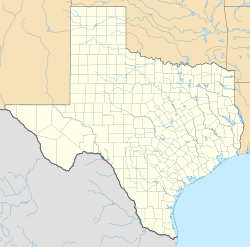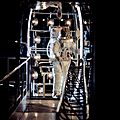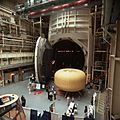Space Environment Simulation Laboratory facts for kids
|
Space Environment Simulation Laboratory
|
|

The 2TV-1 Apollo spacecraft in Chamber A 1968
|
|
| Location | Lyndon B. Johnson Space Center, Houston, Texas |
|---|---|
| Area | less than one acre |
| Built | 1965 |
| NRHP reference No. | 85002810 |
Quick facts for kids Significant dates |
|
| Added to NRHP | October 3, 1985 |
| Designated NHL | October 3, 1985 |
The Space Environment Simulation Laboratory (SESL) is a special building at the Johnson Space Center in Houston, Texas. It's like a giant lab that can create conditions similar to outer space. This includes the extreme cold and the empty vacuum of space.
Built in 1965, SESL was first used to test spacecraft and gear for the Apollo program. Today, NASA still uses it to check if new equipment can survive in space. Because of its important history, it was named a National Historic Landmark in 1985.
Contents
What is the Space Environment Simulation Laboratory?
The Space Environment Simulation Laboratory is a big testing area inside Building 32 at the Johnson Space Center. Its main parts are two large test rooms, called chambers. One chamber is bigger than the other.
Both chambers are shaped like cylinders. They can create a very strong vacuum, which means almost all the air is removed. They also have special lights that can act like sunlight coming from different angles. This helps scientists test how things react to space conditions.
Chamber A: The Big Test Room
Chamber A is the larger of the two test rooms. It is about 45 feet (13.7 meters) wide. The floor inside can spin around 180 degrees. This helps engineers test equipment from all sides.
Four cranes inside the chamber can lift heavy items, each up to 50,000 pounds. Even bigger cranes outside the chamber can lift items weighing 100,000 pounds. These cranes help move spacecraft parts in and out.
Besides sunlight, Chamber A can also create hot plasma fields. These are like the energy fields found in Earth's outer atmosphere. There are also two special airlocks for people. These are used for safety teams during tests with humans. They can also be used for small tests with low air pressure.
NASA updated Chamber A to test the James Webb Space Telescope. As of 2013, it is the biggest high-vacuum, super-cold optical test chamber in the world. It is 55 feet (16.8 meters) wide and 90 feet (27.4 meters) tall. It has a system that can make temperatures drop to -440 degrees Fahrenheit (-262 degrees Celsius). Special cameras and sensors help watch the tests.
Chamber B: The Smaller Test Room
Chamber B is the smaller chamber, about 20 feet (6.1 meters) wide. It has two cranes that can lift 100,000 pounds each. Like Chamber A, it also has two airlocks. One airlock has a water system to create oxygen-rich environments, like those inside a spacecraft.
Its solar lighting system is simpler than Chamber A's. It uses mirrors to get the right light angles. Because Chamber B is smaller, it's faster to set up and test smaller objects. This means more tests can be done quickly.
Images for kids





